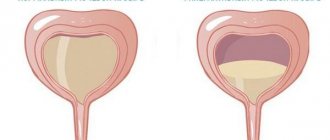How to recognize hormone deficiency
Lack of progesterone in the body leads to infertility.
It is synthesized by the corpus luteum and adrenal glands. It is in them that they look for the cause, determining why progesterone is increased. With normal synthesis, the lining of the uterus is prepared for conception; it increases slightly during periods of ovulation. Unless a woman is ovulating, pregnant or breastfeeding, it is not normal for women to have excess progesterone. Main functions of the hormone:
- Effect on the reproductive system. The second name for progesterone is the pregnancy hormone. The increasing level of the hormone reduces the action of the woman’s immune system, due to which the embryo is not rejected in the event of conception.
- Hormonal state. Increased progesterone in women has a huge impact on the production of other hormones. Estrogen, aldosterone and other hormones are produced more and more actively. In the state of bearing and feeding, this is good.
- Central nervous system. A certain amount of the hormone enters the central nervous system. This is a steroid substance, it allows a woman to more easily endure the hardships of pregnancy and childbirth.
- Libido. There are correlation studies according to which there is a connection between a woman’s sexuality and hormonal levels. In particular, increased progesterone increases libido. But such studies cannot be considered reliable and definitive; they only track the relationship between certain data.
Some doctors argue that low progesterone negatively affects a woman’s appearance. For example, the skin loses its firmness and elasticity, and premature wrinkles appear. This statement is controversial; there is no scientific evidence to support it.
The level of progesterone is never constant; its content fluctuates depending on the day of the menstrual cycle, pregnancy and other factors. The highest levels occur during ovulation and then during pregnancy. If conception does not occur, its production drops sharply, and when monthly bleeding develops, a low level of progesterone is recorded.
After the release of the egg from the follicle, under the influence of progesterone, the corpus luteum is formed - a special temporary gland in the ovaries, designed to ensure fertilization and attachment of the fertilized egg to the endometrium. If conception does not occur, the gland dies, and after a couple of weeks menstrual bleeding occurs.
If conception has occurred, then progesterone continues to be produced by the corpus luteum to support the development of the embryo. The process lasts up to 16 weeks, until the placenta is formed. After this, she will produce a substance to maintain pregnancy.
In addition, throughout pregnancy, the hormone regulates the body’s preparation for the upcoming labor: it blocks active contraction of the uterine muscles and increases the size of the organ. At the same time, under its influence, the mammary glands prepare to secrete milk.
But all this is possible only if the level of the hormone is normal; if for some reason a woman has a lack of it, then the reproductive system is not ready for conception or gestation.
Thus, the functions of progesterone are as follows:
- Preparing the uterus for implantation of the fertilized egg, and if the hormone level is sufficient, the egg is fixed and pregnancy begins to develop.
- Decreased uterine tone during pregnancy, which prevents spontaneous abortion.
- Suppression of the body's defenses to prevent fetal rejection.
- Preventing the occurrence of cysts in glandular tissues.
- Normalization of blood composition and glucose levels.
- Increased sebum production.
Low progesterone in women can be primary or secondary. The first category includes congenital pathologies of the ovaries, hereditary hypo- or aloplasia, and genetically predetermined hormone levels. Acquired deficiency is much more common. The reasons for the deterioration or cessation of progesterone synthesis by the ovaries are:
- various inflammatory diseases
- polycystic ovary syndrome
- injuries, damage
- undergone surgical operations.
Risk factors that increase the incidence of pathology include:
- Violation of the MC
- Pregnancy too early
- Endometriosis
- Diseases of the thyroid gland and adrenal glands
- Breast hyperplasia.
The content of progesterone depends on the MC cycle. During menstruation, the levels drop to minimum values, since due to the absence of pregnancy, the ovaries do not need to produce the substance. Then, as ovulation occurs, production increases and reaches its maximum values by the time the mature egg is released.
The highest levels of progesterone occur during a normal pregnancy - in the 2nd and 3rd trimesters. In this way, the viability and proper development of the fetus is maintained. Then, as labor approaches, the concentration of the hormone gradually begins to decrease.
If the readings are too high even for pregnancy, then this may indicate internal problems. One of them is the deterioration of the placenta, as a result of which it does not provide nutrients and oxygen to the fetus. Such starvation negatively affects the development of the fetus and can cause its death or premature birth.
If a non-pregnant woman has increased progesterone in the luteal phase and in other stages of the cycle, this may indicate serious gynecological problems. The reasons are:
- Adrenal gland dysfunction
- MC failure due to oncological tumors
- Hidden bleeding
- Impaired kidney function, etc.
To eliminate the pathology, the woman will have to undergo an examination, based on the results of which treatment will be prescribed.
Low progesterone occurs for many reasons. Its content can be determined using tests, but there are other signs that should alert you. Signs of progesterone deficiency:
- Breast pain and swelling
- Violation of the MC
- Bleeding
- Flatulence
- Weakness, fatigue
- Head pain
- Heavy sweating
- Mood lability.
If the examination reveals that the cause of illness or inability to become a mother is hormone deficiency, then special medications will be prescribed.
There are various drugs that are prescribed to restore low progesterone in women and the pathologies caused by it.
Utrozhestan
The drug contains a natural hormone of the corpus luteum. It is produced in capsules that can be used orally or intravaginally. The drug is available with different contents of the active component - 100 and 200 mg.
Indicated to eliminate infertility if there is very low progesterone in the luteal phase, PMS, MC disorders, mastopathy, premenopause, threat of miscarriage and other pathologies caused by hormone deficiency.
Crinon
A preparation with progesterone in the form of a gel. Designed to ensure the required level of luteinization in preparation for VMR, eliminating secondary amenorrhea, bleeding from the uterus if caused by hormone deficiency.
The gel is applied intravaginally once a day, preferably at night. Usually well tolerated, side effects are mainly local reactions (pain, burning at the application site, bloody discharge). A few systemic effects include headaches and vertigo.
Duphaston
The drug contains dydrogesterone, an artificial analogue of the endogenous hormone. The substance differs favorably from other similar synthetic compounds in that it does not have the effects characteristic of testosterone.
The drug is prescribed to normalize hormone levels in cases of progesterone deficiency, endometriosis, infertility caused by low luteinization, MC failure, and also as a source of progesterone in cases of natural or surgical menopause.
The medicine is indicated for expectant mothers in case of threatening conditions, if they were caused by a lack of progesterone during pregnancy, and there is a threat of its termination.
The drug is developed in tablets, the content of the active substance is 10 mg in one pill.
The application scheme is selected in each case individually. The recommended single dose for administration is from 5 to 10 mg, the daily dose is up to 30 mg. Frequency of administration – up to 3 times a day.
Progesterone
The drug contains the component of the same name and is produced in the form of an oil solution for intramuscular injections. It comes with different contents of the active substance - 10 mg or 25 mg per 1 ml.
The drug is prescribed if there is a lack of progesterone in women, symptoms of miscarriage. The drug is indicated for rapid replenishment of the hormone when a quick result is very important: when there is a threat of miscarriage, insufficient thickness of the endometrium, which is not able to hold the fertilized egg.
Features of the course are determined personally in accordance with the indications. Side effects are an increase in blood pressure, difficulty removing fluid, as a result of which swelling develops.
Iprozhin
Medicines with progesterone in capsule form. Each pill contains 100 mg of the hormone. The drug is used orally or intravaginally to eliminate progesterone deficiency and the pathologies caused by it: PMS, mastopathy, during menopause. It is used in preparation for artificial insemination and as a means of replacement HT for hormonal imbalance.
Features of use are determined by the treating specialist. On average, it is recommended to take 2 to 3 capsules orally per day for 10 days.
Intravaginal use: daily dosage is from 1 to 3 capsules.
Prajeesan
Hormonal drugs are produced in the form of oral capsules and intravaginal gel. Contains a hormone, prescribed to eliminate its deficiency and prevent pathological conditions (PMS, circulatory disorders, anovulation, infertility due to lack of progesterone), and maintain pregnancy. also used in HRT, in preparation for artificial insemination, to prevent endometriosis and miscarriages.
The progesterone content in one capsule is 200 mg, in 1 g of gel – 80 mg.
Progesterone in the luteal phase is increased and menstruation
With normal functioning of the reproductive system of every woman, approximately on the 15-17th day of the cycle after ovulation, a very important period begins - the luteal phase. Under normal circumstances, at this time the mature egg leaves the dominant follicle, and the corpus luteum, which produces the pregnancy hormone, begins to perform its function. Progesterone increases sharply in the luteal phase, which contributes to the formation of a denser endometrium. This happens so that the fertilized egg can find a place for itself and firmly attach to the wall of the uterus.
With normal functioning of the reproductive system of every woman, approximately on the 15-17th day of the cycle after ovulation, a very important period begins - the luteal phase.
Under normal circumstances, at this time the mature egg leaves the dominant follicle, and the corpus luteum, which produces the pregnancy hormone, begins to perform its function. Progesterone increases sharply in the luteal phase, which contributes to the formation of a denser endometrium. This happens so that the fertilized egg can find a place for itself and firmly attach to the wall of the uterus.
The production of progesterone in the luteal phase indicates the body's readiness to become pregnant. However, if fertilization does not occur, the corpus luteum dies, reducing the level of progesterone, and is rejected by the ovaries, which is why the next cycle begins. This is a well-established process that is regulated by progesterone. When its quantity changes, various types of disruptions begin in the menstrual cycle.
The duration of the luteal phase is approximately 12-14 days. With individual characteristics, this period can increase to 16 days. If ovulation occurs earlier than 10 days before the onset of menstruation, this indicates a violation of progesterone production.
To understand how efficiently a woman’s body works, or if problems arise with pregnancy, a blood test is performed to measure progesterone levels. As a rule, it is prescribed on day 21 of the cycle, which corresponds to the luteal phase. Consequently, the results obtained are of undeniable importance in making the correct diagnosis and determining further treatment methods.
The norm varies from 7 to 56.6 nmol/l.
If this limit is increased or decreased, the necessary therapy must be carried out to normalize the process of ovarian function. After ovulation, the progesterone level is at the limit of 7 nmol/l, but after 7-9 days it reaches its maximum value of 56.6 nmol/l. This is a sign of normal ovulation.
Only a timely blood test helps determine how effectively a woman’s reproductive system works.
Signs of high progesterone:
Increased sensitivity of the mammary glands
Bleeding from the vagina
Reasons that can result in a sharp increase in progesterone:
Failure of normal menstruation
Fibrous cyst on the corpus luteum
Deviations of the adrenal glands
Taking progesterone-containing drugs.
A significant increase in progesterone can provoke the development of epilepsy, kidney dysfunction, osteoporosis and cardiovascular diseases.
To avoid an excessive increase in progesterone in the luteal phase, you must:
Before taking hormonal medications, be sure to conduct tests and consult with your doctor.
Based on tests and individual predisposition, choose oral contraceptives.
Low progesterone in the luteal phase is primarily a sign that the ovaries are not working properly and pregnancy becomes impossible. Favorable conditions for the attachment of the fertilized egg will not be created on the surface of the uterus, so even in the event of fertilization, menstruation will occur.
Also, low levels of the hormone may indicate chronic inflammation and manifest as uterine bleeding. It is one of the symptoms of infertility.
The main cause of progesterone deficiency in the luteal phase is insufficient functionality of the corpus luteum. To solve the problem, be sure to take hormonal medications.
source
If a woman’s reproductive system works smoothly, then the luteal phase begins approximately on the 15th day of the monthly cycle.
During this period, the oocyte leaves the follicle and the corpus luteum synthesizes hormones that promote implantation of the fertilized egg. If the cycle undergoes changes, the woman will experience problems with fertility.
- The luteal stage begins immediately after the release of the egg.
- During the phase, the amount of the hormone should increase.
- An excessive increase in progesterone levels in the second phase threatens the formation of ovarian tumors.
- A decrease in hormone levels leads to the development of infertility.
- Progesterone production disorders should be treated by a doctor.
At the beginning of the phase, the egg is released from the dominant follicle. At this time, the corpus luteum begins to produce progesterone. This substance promotes compaction of the endometrium. This phenomenon is necessary for the zygote to attach to the inner mucous membrane of the uterus.
The fact that progesterone is synthesized in the luteal phase suggests that a woman can become pregnant. If the egg has not been fertilized, then the corpus luteum regresses. This moment gives rise to a new cycle.
The duration of the luteal stage is from 12 to 14 days. In some cases, this time can increase to 16. If ovulation occurs 10 days before the onset of menstrual bleeding or even earlier, this indicates a disruption in the processes of progesterone synthesis.
A hormone defect can be diagnosed using an ultrasound examination.
In order to study the state of reproductive health, women are prescribed a blood test for progesterone. It is done for 21 days. The physiological indicator of the hormone at this time ranges from 7 to 56 nmol / l.
After ovulation, the norm of progesterone in the luteal phase is 7 nmol. After 7 days it reaches its maximum value. This is a sign of healthy functioning of the body.
Hormone levels may increase for the following reasons:
- beginning of pregnancy;
- disruption of the normal menstrual cycle;
- the presence of a cyst in the corpus luteum;
- kidney failure;
- taking medications containing progesterone.
A low level of the hormone indicates improper functioning of the ovaries, as a result of which pregnancy is not diagnosed. Due to low progesterone, normal conditions for embryo implantation are not created on the surface of the uterus. Therefore, the main symptom of the disease is infertility.
Low progesterone in the luteal phase indicates inflammatory disease of the ovaries and uterus. Due to the functional insufficiency of the corpus luteum phase, the body does not produce progesterone in the required amount, with all the ensuing consequences for female reproductive health.
Other symptoms of progesterone deficiency:
- sharp pain in the head area;
- weight gain;
- growth of mammary glands;
- constant change of mood.
To determine whether ovulation is occurring correctly, the patient is prescribed laboratory tests. They show what type of therapy is needed in the future.
In severe cases, progesterone injection helps maintain pregnancy. If deviations occur during pregnancy, constant contact with your doctor is necessary.
If a patient develops polycystic ovary syndrome, she is usually prescribed oral contraceptives. They prevent the development of the disease.
Hormone replacement therapy can only be used as prescribed by a doctor. Leading domestic and foreign gynecologists warn patients about the dangers of self-medication.
During pregnancy, normal readings are:
- from 5 to 7 weeks. - 22.6 - 33.26 nmol / l;
- 8 - 10 weeks - 57.24 - 92;
- 11 - 13 weeks - 48.33 - 85.8;
- 14 - 16 weeks - 61.7 - 109.4;
- 17 - 20 weeks - 59.78 - 159;
- 21 - 23 weeks - 67.92 - 181.26;
- 24 - 27 weeks - 79 - 156.
Subsequently, the hormone level increases until delivery.
To prepare for the test, you should follow these recommendations.
- In order to ensure the most accurate results, a woman needs to know exactly the beginning and end of menstruation.
- You do not need to eat food 8 hours before the test. The exception is clean water.
- The day before the blood test, you should stop drinking alcohol.
- It is worth telling your doctor about the medications you are taking. In some cases they can influence the result.
- The day of the test may be scheduled by the doctor at another time, if necessary.
First of all, with high levels of progesterone, women are prescribed drugs that suppress the activity of the hormone - Yarina, Janine, Mifepreston, Clomiphene, Tamoxifen.
Treatment of the underlying disease that causes hyperprogesteronemia is indicated. When diagnosing a cyst, anti-inflammatory therapy is usually used along with oral combined contraceptives.
In severe cases, ovarian resection is performed. Patients are prescribed antitumor drugs.
If the functioning of the adrenal glands is disrupted, appropriate therapy is indicated.
Decoctions of clove flowers, boron uterus, and rowan fruits help reduce the amount of progesterone in the blood. To prepare them, 1 tbsp. raw materials are poured into a glass of water and boiled for 5 minutes, left for half an hour. Take 0.5 cups 2-3 times a day.
The duration of treatment with decoctions is no more than 2 weeks.
For the disease in question, it is necessary to exclude fatty foods, sweets, nuts, legumes, and chicken from the menu. Fermented milk products with limited calorie content, vegetable oil, and lean meat are useful. It is recommended to drink mint tea.
High progesterone in the second half of the monthly cycle is characterized by the following symptoms:
- hypersensitivity of the mammary glands;
- mood changes;
- the appearance of bloody discharge from the vagina;
- pain in the head;
- decreased sex drive;
- flatulence;
- decrease in blood pressure;
- frequent and prolonged migraines.
Sometimes acne appears in large numbers on the patient’s body. They are very deep and occupy almost the entire thickness of the skin. Sometimes women's hair becomes terribly brittle and gradually begins to fall out.
Elevated hormone levels cause the following complications:
- tumors of the ovaries or adrenal glands;
- severe acne;
- severe menstrual irregularities;
- polycystic ovary syndrome;
- miscarriage;
- stillbirth.
Based on the results of the analysis, it becomes clear at what stage the cycle is and what is the content of progesterone in the blood. To decipher the results of progesterone levels in the luteal phase, there are specially developed techniques. They often differ between laboratories.
During the luteal period of the cycle, progesterone should show levels slightly higher than in the first phase. Hormone deficiency indicates severe disorders of the reproductive system.
source
Increased progesterone in the luteal phase, provided that the woman is not carrying a child, indicates the presence of chronic diseases of the reproductive system.
Diseases with a characteristic surge in progesterone levels develop against the background of malignant ovarian tumors.
Hormone deficiency provokes infertility; the lower progesterone levels, the less chance of conceiving.
Progesterone is a hormone of the female reproductive system, responsible for the fullness of the second phase of the menstrual cycle. For the possibility of conception and for all stages of pregnancy. Produced by the adrenal glands and the corpus luteum (temporary gland). During pregnancy, it is also produced by the placenta.
Female hormonal levels cannot be characterized as constant, therefore hormonal levels can fluctuate, depending on the general state of health.
Reference standards for hormone concentrations are determined by the phase of the menstrual cycle. During phase I, a prolonged increase in hormone levels is observed, right up to ovulation. At the time of ovulation, there is a peak progesterone surge (about 0.48-9.41 nanograms per millimeter). If there was no fertilization, then by normal value gynecologists understand an indicator in the range of 0.32-2.23 nanograms per milliliter.
Due to the constant change of phases in the cycle, the hormone level also changes values. Therefore, there are several instructions for donating blood that allow you to conduct tests with high accuracy.
Their compliance is necessary, since it is necessary not only to establish the level of progesterone, but also to determine the degree of pathology of the condition in correlation with the level of estradiol.
The luteal phase is the second half of the cycle when progesterone is at its highest. According to research, the level of the hormone rises almost 10 times. The absence of a surge or deficiency of the hormone indicates gynecological problems.
An ovulation test will help you find out whether the level of progesterone concentration in the blood is adequate. And specific tests are taken on the 23rd day from the start of menstrual bleeding, provided that the cycle consists of 28 days. If it is longer (32-36 days), then the analysis, accordingly, is shifted to 28-29 days.
The irregularity of the cycle forces doctors to repeat the analysis several times, and the woman must measure her basal temperature from the first day after the end of menstruation until the start of new bleeding.
If the level of progesterone and estradiol decreases or increases, then symptomatic complexes develop, indicating a primary disease. The main symptoms include tenderness and engorgement of the mammary glands, uncontrollable emotional swings, bloating, and bleeding from the vagina (not at all related to menstruation).
The main reason for the increase in progesterone levels is pregnancy, but if it is not detected, and hormonal levels continue to rise and are at a critical level, then it is assumed:
- dysfunctional disorders of the adrenal glands;
- pathological disturbance of menstruation due to a malignant tumor;
- hidden uterine bleeding;
- corpus luteum cystosis;
- renal failure.
The initial cause can only be determined through a full examination.
During pregnancy, elevated levels of progesterone, although physiological, require constant medical attention and monitoring.
With congenital organic lesions of the adrenal cortex, women develop infertility. But in some cases, symptoms do not appear and the child can be delivered without complications. Therefore, an increase in the level of OH-progesterone, caused by problems in the functionality of the adrenal glands, worries doctors no less.
The steroid hormone progesterone ensures the normal course of pregnancy. What is the normal level of progesterone in women and how to get tested for the hormone correctly, read on our website.
When and why to take tests for FSH, LH and prolactin, we will tell you here.
Follow this link https://gormonexpert.ru/gormony/progesteron/kogda-sdavat-na-kakoj-den-cikla.html you will learn on what day of the cycle you need to take progesterone and how to correctly take the test for women with irregular cycles.
Since progesterone is involved in many life support processes of the body, fluctuations in its level in any direction immediately appear.
In the first days of the cycle, little hormone is produced; by the beginning of the luteal period (about 15 days), ovulation occurs and progesterone levels rise rapidly. Once pregnancy occurs, this growth continues continuously.
Pathological hormone surplus, not caused by conception, has its own symptoms:
- Deep subcutaneous pimples appear on the face, body and head.
- The woman constantly feels lethargic and tired.
- The menstrual cycle is irregular.
- Low blood pressure.
- Acquired infertility is diagnosed.
- Frequent migraines and attacks of hyperhidrosis appear.
- Depression develops.
Additional symptoms include bloating, weight gain, brittleness, excessive oiliness and hair loss.
An increased level of OH-progesterone causes:
- tumors of the adrenal glands and/or ovaries;
- severe acne;
- menstruation cycle disorders;
- polycystic ovary syndrome;
- stillbirth, miscarriage (during pregnancy).
In a healthy woman, progesterone levels are normal according to age and phase of the menstrual cycle. Several methods are used to treat hormonal surges. The most reliable among them can be considered the method of drug correction. Self-medication is unacceptable; if a woman does not want to resort to pharmaceuticals, the doctor will recommend using folk remedies.
You can lower progesterone levels with the following drugs:
Before starting the course, you need to exclude pregnancy, otherwise each of these medications can cause a miscarriage.
Particular caution is required when prescribing for diabetes mellitus, renal dysfunction, diagnosed epilepsy, heart failure, migraines, and depressive states. And also during ectopic pregnancy and during breastfeeding.
Progesterone levels are affected by excessive consumption of foods rich in proteins. The diet is adjusted according to the “reverse” principle. It is necessary to temporarily exclude hard cheeses, fermented milk products, chicken, legumes, beef, and pumpkin seeds from the menu. It is better to drink lunch and dinner with mint tea, which promotes hormonal stabilization.
As folk methods, a decoction of the fruits of bitter rowan, clove flowers, and green mass of the uterus is considered. Each of these herbs can be purchased at a pharmacy kiosk.
It is better not to delay therapeutic measures to stabilize progesterone levels.
If you suspect a hormonal imbalance, you should consult a gynecologist, since critically high progesterone in the luteal phase causes the early development of osteoporosis, inflammatory processes in the kidneys, heart and vascular diseases, and epileptic seizures.
During pregnancy, progesterone levels increase, but there are cases of a pathological increase in the concentration of the hormone. Increased progesterone in a woman - what are the reasons and what can be done?
How to properly take a progesterone test and how to properly prepare for it, read in this topic.
source
Progesterone is a hormone whose main functions are to prepare the female body for conception and ensure the normal course of pregnancy. Its concentration depends on the stage of the menstrual cycle. An increased level of the substance in the luteal phase, which lasts from the moment of ovulation until the onset of menstruation, is observed during pregnancy. If conception does not occur, and the indicators exceed the norm, this may indicate pathologies.
The concentration of the hormone depends on the phase of the menstrual cycle and the age of the woman. The substance is produced by the adrenal glands and ovaries. With the onset of the luteal phase, its level rises sharply. After the release of the egg from the follicle, the corpus luteum is formed - a temporary gland that also synthesizes progesterone. Its increased concentration during this period of the menstrual cycle helps prepare the endometrium of the uterus for embryo implantation.
Peak hormone levels occur on days 20–23 of the cycle. A progesterone test is usually prescribed during this period of the luteal phase. If fertilization does not occur, the corpus luteum regresses and progesterone concentration drops. When pregnancy occurs, the temporary gland continues to synthesize the substance until the 16th week, after which the placenta takes over this function.
The level of the hormone is determined by testing blood from a vein. The table shows its norms by age and cycle phases:
| Age/cycle phase/gestational age | Minimum progesterone level, nmol/l | Maximum progesterone level, nmol/l | |
| Girls | |||
| Age | 0–9 years | 0 | 1,1 |
| 9–13 years | 0 | 1,8 | |
| 13–18 years old | 0,3 | 30,4 | |
| Women | |||
| Cycle phase | Follicular | 0,3 | 2,2 |
| Ovulatory | 0,5 | 9,4 | |
| Luteal | 7,0 | 56,6 | |
| Menopause | 0 | 2,3 | |
| Pregnant | |||
| Gestational age | 1st trimester | 8,9 | 468,4 |
| 2nd trimester | 71,5 | 303,1 | |
| 3rd trimester | 88,7 | 771,5 | |
Excess progesterone in the luteal phase can be associated with the onset of pregnancy, and in case of multiple pregnancy its level is higher than in case of singleton pregnancy. If fertilization does not occur, and the hormone concentration is increased, the cause may be pathologies:
- tumors of the ovaries and uterus;
- hydatidiform mole;
- uterine bleeding;
- liver and kidney failure;
- absence of menstruation for six months or more;
- cysts of the reproductive organs and corpus luteum;
- adrenal gland diseases.
Progesterone affects many systems in the body. High levels of the hormone negatively affect the functioning of the reproductive organs, causing cycle disruption and pain in the pelvic area. The breasts become painful and increase in size. The functioning of the digestive system is disrupted: bloating, constipation and diarrhea appear. The condition of the skin and hair worsens, and sudden weight gain may occur.
Symptoms from the nervous system include weakness and fatigue. A woman may feel depressed and notice a decrease in attention and memory. Headaches and dizziness often appear.
It is necessary to start treatment immediately after detecting a deviation, since it can lead to infertility, obesity, diseases of the heart and blood vessels, kidneys, and adrenal glands. Treatment tactics are selected depending on the cause of the pathology. To normalize hormonal levels, oral contraceptives and progesterone antagonists are used.
Treatment of cysts and neoplasms, hydatidiform mole is carried out surgically. In case of renal and liver failure, diet, diuretics, choleretic and antibacterial drugs, vitamin therapy, and, if necessary, hemodialysis are required. Diseases of the adrenal glands require hormone therapy, the use of glucocorticoids and antibiotics.
General information
Progesterone deficiency is otherwise called corpus luteum or luteal phase deficiency. The synonymous names are due to the fact that the corpus luteum normally produces the hormone progesterone in the second (luteal) phase of the menstrual cycle - if its function is reduced, this endocrine syndrome occurs.
There is no exact data on the prevalence of the disorder in gynecology, as it is often confused with other forms of hormonal imbalance in women. The diagnosis is made when there is a low level of the hormone during an ovulatory menstrual cycle. At the same time, this condition can itself provoke a cascade of endocrine disorders, including leading to an anovulatory cycle, which further complicates the diagnosis of the underlying pathology. It is believed that the disorder most often develops in women aged 18-25 years.
Progesterone deficiency
What 6 reasons most often lead to increased progesterone?
The list of factors that can cause hormonal imbalance is very wide. In clinical practice, 5 causes of too high progesterone are more common than others.
Reason 1 – unstable menstrual cycle
In particular, the luteal phase is too long. Normally, this happens in girls and premenopausal women entering puberty and is associated with excessive synthesis of follicle-stimulating hormone (FSH). Pathology is said to occur when there is “reduced ovarian reserve,” a depletion of ovarian functionality due to illness or other disorders (3).
Reason 2 – decreased estrogen levels (relative progesteronemia)
Such conditions occur during menopause and severe problems with the ovaries, uterus, and adrenal glands. Another unobvious reason for relatively high progesterone levels is stress. Overstrain of the nervous system leads to a malfunction in the hypothalamus, which regulates the synthesis of sex hormones, and the production of estrogen sags and decreases (4).
Reason 3 – taking drugs with progesterone
A typical reason for this is the prevention of pregnancy complications and miscarriages. Preparations with progesterone are used in IVF (in vitro fertilization) schemes. It is better to use forms for vaginal use, as they have less effect on the level of progesterone in the blood (5). Progesterone also has a protective effect on brain tissue (neuroprotective effect) and can be prescribed to treat TBI (6).
Reason 4 – pregnancy
The most natural reason for increasing the level of progesterone in the blood. This hormone, intended by nature to maintain pregnancy, is synthesized by the placenta from the moment of its formation until the birth itself. During the first and second trimesters, the amount of progesterone secreted increases, and by the end of gestation it decreases (7, 8).
Reason 5 – disorders of the adrenal glands
This can be either problems in the adrenal gland itself (hormone-producing tumor), or pathology of the pituitary gland, which begins to synthesize too much adrenocorticotropic hormone (ACTH). Under the influence of this substance, the adrenal glands are activated and begin to secrete more progesterone (9).
Reason 6 – correction of negative effects of menopause
To relieve hot flashes, night sweats and improve sleep, women in the premenopausal period or menopause can take progesterone preparations or its precursors (pregnenolone). There is also evidence that such therapy reduces the risk of breast cancer to a greater extent than the use of estrogens during menopause (10).
There are also times when a woman is found to have low levels of the pregnancy hormone. Then she can try to increase progesterone in natural ways. The peculiarity of these methods is that they normalize hormonal balance, but sometimes, if the recommendations are not followed correctly, the level of progesterone can become higher than recommended.
The amount of progesterone is normal
So you've had your progesterone test. I will give a table that shows the reference values and norms of progesterone in women. You can save it to track when the level reaches a positive mark. From the table it becomes clear that progesterone levels in women vary depending on the phase.
If there is a deviation in the level of a hormone (any), then you need to contact an endocrinologist or gynecologist. It is even better to consult a gynecologist-endocrinologist. The information presented below is not a guide to action. A face-to-face meeting with a specialist is required, because all cases are individual.
Low progesterone
What signs may indicate low progesterone in women. Look at the picture and analyze whether you notice these symptoms in yourself. If yes, then you need to consult a specialist. This will solve the problem and avoid deterioration.
To get reliable test results, you need to know on what day of the cycle you can donate blood for progesterone. To do this, it is necessary to understand how its level changes over certain periods of time.
The concentration of progesterone in the blood varies depending on the phase of the menstrual cycle. During the follicular phase it is minimal, since during this period the hormone is produced only by the adrenal cortex. After ovulation, the follicle located on the surface of the ovary turns into the corpus luteum. This temporary gland secretes 80% of all luteal phase progesterone.
There is no standard norm for hormone production on a permanent basis. It is produced in different quantities, depending on the current cycle and period of a woman’s life. An increase in output is observed under the following circumstances:
- At the end of the menstrual cycle;
- During ovulation;
- During pregnancy;
- While breastfeeding.
In all of these cases, the hormone levels are increased. During childbirth, menopause, and between menstrual cycles, the amount of hormone produced decreases.
The general rule is also not always valid. The level of progesterone often depends on the emotional state, the amount of physical activity and sleep, and the woman’s lifestyle. Therefore, cases are taken into account when there is a significant excess of progesterone in a woman and the symptoms accompanying this.
Correction of hormonal imbalances
Of course, if you find that any of the above hormones are abnormal, there is no need to panic. Why? The thing is that any deviation with a good diagnosis can be quickly and painlessly corrected. Treatment of hormonal imbalances, despite the delicacy of the problem, is currently very developed.
If you find out that you have too much or too much of one or another hormone, all you need to do is consult a specialist. Next, you will be given a complete blood test, based on the results of which a course of medications that make up the treatment will be prescribed.
It is worth mentioning separately about the various methods of traditional medicine that are recommended to be used if low progesterone is detected. Yes, it is necessary to treat the deviation, but in no case should you rely on traditional methods. The deficiency of any hormone is a consequence of a number of factors and reasons that traditional medicine in most cases does not consider.
In other words, if you start trying to cure progesterone deficiency, if you have increased estrogen, and the traditional method does not provide for such a situation, complications may develop that are quite difficult to cure even with the help of modern medicine. Therefore, the only sure way to correct hormonal imbalance is to consult a specialist.
Causes of hormone deficiency
The main reason for a strong and sudden excess of progesterone is pregnancy. Starting from the first weeks after conception, the female body produces a lot of the hormone. As mentioned above, there are several physiological reasons for this, including suppression of the immune response to maintain pregnancy. If a woman is not pregnant, the increase in progesterone occurs for various reasons:
- Ovarian oncology (malignant tumors);
- Complete disruption of the menstrual cycle, absence of menstruation for more than six months (amenorrhea);
- Corpus luteum cyst;
- Kidney dysfunction or failure;
- Uterine bleeding;
- Use of hormonal drugs;
- Dysfunction of other organs (including the heart);
- Osteoporosis;
- Epilepsy.
Having discovered symptoms of excess progesterone, the woman and her doctor will undergo a full examination of the body to identify the root cause or disease that caused the jump in production.
The reliable causes of endocrine syndrome are unknown; there are only assumptions about the influence of disorders of various natures on its development. Among them:
- Genetic factors, for example, aberrations of the X chromosome and some mutations affecting the functioning of the ovaries, pituitary gland, and enzyme systems. Such disorders can lead to hereditary transmission of the endocrine disorder from mother to daughters.
- Ovarian damage. Pathology can be caused by polycystic disease, traumatic lesions or ovarian tumors.
- Disruption of the pituitary gland. Injuries and tumors of the gland lead to numerous endocrine disruptions, including those affecting sex hormones.
- Diseases of other organs and systems. The development of progesterone deficiency is observed against the background of kidney pathologies (CKD, pyelonephritis), liver, diabetes mellitus, thyrotoxicosis and other disorders.
- Woman's lifestyle. Bad habits (smoking, drinking alcohol), obesity, excessive physical (including sports) exercise, and diets can also contribute to the development of progesterone deficiency.
Many factors play a role in the development of the syndrome. There are indications of a persistent decrease in progesterone levels in the luteal phase in some women after long-term use and discontinuation of combined oral contraceptives. Isolated cases of progesterone deficiency occurring during treatment of hypothyroidism, the use of growth hormone and other hormonal drugs have been described.
Initially, the manifestations are erased, the symptoms gradually increase as hormonal imbalances progress. The first sign is a disturbance in the menstrual cycle - its duration increases or decreases, menstruation becomes painful, and the amount of discharge changes. This picture can persist for a long time (months and years). The next most common manifestation of the syndrome is infertility, manifested by either a lack of conception or frequent spontaneous miscarriages. If the fetus is preserved, pregnancy proceeds with complications - fetal hypoxia, polyhydramnios or oligohydramnios, premature birth.
Concomitant symptoms of progesterone deficiency are iron deficiency anemia due to heavy menstruation, decreased libido in women, and signs of other endocrine disorders. Women who use the method of measuring basal temperature for contraception reveal its insufficient increase in the second phase of the menstrual cycle. A reduced secretion of progesterone is indicated by a temperature difference of less than 0.4-0.5 degrees between the ovulatory (first) and luteal (second) phases. Swelling associated with water retention in the body, premature aging of the skin, and irritability may also occur.
For progesterone deficiency, replacement therapy is used - progesterone preparations. They can be used in the form of tablets, capsules, vaginal suppositories; in hospital settings, oil solutions are prescribed for intramuscular administration. The course of treatment is developed by an obstetrician-gynecologist or endocrinologist, strictly taking into account individual characteristics. These are the presence or absence of pregnancy, the duration of the menstrual cycle, the level of endogenous progesterone in different phases. The duration of treatment depends on its goals (for example, successful pregnancy and childbearing), the causes of the syndrome, age and other factors.
An auxiliary role in the treatment of the condition is played by the normalization of general hormonal levels, elimination or relief of pathologies of other organs and systems. It is necessary to get rid of bad habits, if any, to avoid exhausting diets and significant physical activity. To reduce the effects of emotional stress, sedatives and, in some cases, antidepressants can be prescribed. Treatment of complications of progesterone deficiency - iron deficiency anemia, endometritis, mastopathy - is carried out by appropriate specialists according to indications. In some cases (with polycystic ovary syndrome), surgical intervention may be prescribed.
Increased progesterone in women during pregnancy is considered normal; in other cases, a change in level is regarded as a pathology.
Hyperprogesteronemia occurs in the following conditions:
- amenorrhea;
- malignant tumors of the adrenal glands or ovaries;
- hydatidiform mole;
- uterine bleeding;
- multiple pregnancy;
- corpus luteum cysts;
- congenital anomalies of the ovaries;
- liver pathologies;
- renal failure.
Taking certain medications also affects the balance of progestogen in the blood; antifungal, antiepileptic, and hormonal drugs have this side effect.
The symptoms of hyperprogesteronemia are nonspecific; its manifestation is difficult to differentiate from other diseases. Women experience disruptions in the menstrual cycle, apathy appears, and performance decreases. Bloody discharge from the genital tract, headaches, and discomfort in the lower abdomen and lower back are often observed. The condition of hair and skin worsens.
If a woman's 17-OH progesterone levels exceed the norm, problems may arise with conceiving and bearing a child. In addition, the risk of developing pelvic tumors and osteoporosis increases.
Therapeutic tactics for hyperprogesteronemia are determined in accordance with the cause that caused it. Malignant neoplasms are subject to surgical removal followed by chemotherapy. Cysts and benign tumors are often hormone-dependent, in which case drug therapy is prescribed. The following groups of drugs are usually used:
- Antigestagens. They block progesterone receptors, reducing tissue sensitivity to hubbub. Inhibits the growth of tumors and fibroids.
- Combined oral contraceptives. They suppress ovulation, as a result the function of the corpus luteum decreases. Treatment with drugs must be combined with diet therapy. The daily diet includes more vegetables, fruits, and herbs. Consumption of protein foods is limited.
Hormone functions
Progesterone is synthesized in a woman's adrenal glands and ovaries. By the way, it is also present in the body of men, although its level there does not change, and it is found in men in much smaller quantities.
In a woman’s body, progesterone performs a number of very important functions:
- Participates in the process of attachment of a fertilized egg to the wall of the uterus.
- The second important function of the hormone is the complete cessation of the menstrual cycle during pregnancy.
- By influencing the uterus, it does not allow it to contract spontaneously. Such contractions can cause miscarriage.
- Under the influence of progesterone, the uterus begins to grow and stretch.
- Increases blood pressure. Thus providing the woman’s genital organs, including the uterus, with an influx of oxygen.
In other words, pregnancy cannot proceed without progesterone.
Symptoms of progesterone deficiency
The exact amount of the hormone can only be detected through a clinical examination of the patient’s blood. But it is believed that there are typical symptoms of excess progesterone:
- Constant acne on the skin throughout the body, regardless of the menstrual cycle;
- Increased amount of hair growing on the body (this rarely affects the scalp);
- Weight gain and difficulty losing weight;
- Depression, stress without external stimuli, fatigue;
- The manifestation of frequent allergies or reactions to objects to which the woman had not previously reacted;
- Unreasonable jumps in blood pressure in a calm state;
- Pain in the mammary glands (especially on the eve of menstruation);
- Menstrual irregularities;
- Bloody vaginal discharge outside the cycle.
The manifestation of one or two signs is usually not taken into account. The combination of several of them is considered sufficient to conduct a clinical analysis of progesterone levels. At the same time, doctors are looking for reasons for the increase in progesterone in a woman.
Typically, doctors recommend progestins, natural progesterone, or COCs. Drugs that contain progestins or progesterone are prescribed exclusively for low progesterone levels. It may also be due to a medical condition. They should never be used for personal reasons. Hormones do not tolerate any “self-medication”!
Personally, I often come across situations where these drugs are prescribed as contraceptives. If you take them for a long time, then some of the consequences are difficult to resolve. Hormone replacement therapy should only be considered if non-drug therapy has failed.
Progestins
These include: Charozetta, MODELL, Desogestrel, Lactinet. This group of drugs are synthetic analogues of progesterone. But they are not completely identical to the natural hormone, since there is a difference at the molecular level. They are prescribed as contraceptives, instead of COCs, if the mother is breastfeeding or has a genetic predisposition to thrombosis.
These drugs are contraindicated during pregnancy!
Progestins can be prescribed as part of a comprehensive regimen for the prevention of ovarian cancer and recurrent endometriosis. They are also taken to restore hormonal balance when diagnosed with estrogen dominance syndrome. There is information that progestins in high dosages reduce the level of antibodies to thyroid tissue.
The effect of low progesterone on the female body
First of all, changes in well-being occur. Then there are more serious problems:
- Miscarriage. A decrease in progesterone in the 1st trimester of pregnancy is especially dangerous. In most cases it leads to miscarriage.
- Estrogen dominance. If girls experience a decrease in progesterone, estrogen begins to dominate. This often leads to excessive irritability, and in some cases even to the absence of menstruation. In the future, such dominance may be a problem in conceiving a child. Increased estrogen is dangerous for women. This leads to the fact that the endometrium thickens greatly and there is a risk of developing cancer. Therefore, progesterone levels are very important to control.
- Low progesterone levels prevent a woman from becoming pregnant. Menstruation begins and pregnancy does not have time to occur. If the hormone level is normal, then the corpus luteum continues its mission until the placenta replaces it. Before conception, it is recommended to take a test to determine your progesterone level. This will help not only to get pregnant, but also to carry a child to term.
Pathogenesis
With progesterone deficiency, the corpus luteum formed after ovulation produces an insufficient amount of progesterone, which causes a cascade of disorders. Normally, this hormone moves the endometrium into the secretory phase, preparing the conditions for embryo implantation. When pregnancy occurs, it reduces the motor activity of the uterus and stops the development of immune reactions to the fetus. Insufficient levels of progesterone disrupt the structure of the endometrium, making implantation difficult. If it does occur, then an insufficient decrease in the tone of the uterus and the activity of the immune system creates a threat of termination of pregnancy. Subsequently, according to the feedback principle, progesterone deficiency leads to reduced formation of FSH, decreased estrogen secretion and slower follicle formation for the next ovulation. Estrogen-progesterone deficiency develops, and an anovulatory menstrual cycle occurs.
There are several theories about the molecular pathogenesis of progesterone deficiency. The generally accepted hypothesis sees the cause of the syndrome in changes in endocrine feedback, which leads to an imbalance in the proportion between the levels of follicle-stimulating hormone (FSH) and luteinizing hormone (LH). This may be due to changes in receptor sensitivity or abnormalities in signaling circuits due to a genetic defect. The same disorder is caused by abnormal levels of other hormones (sex, thyroid, pituitary). Other theories for the development of the disorder point to the possibility of defects in endometrial receptors or the occurrence of oxidative stress with the release of large amounts of free radicals in the tissues of the uterus and ovaries.
Laboratory blood test
The hormonal level in a woman's blood is measured several times. This is necessary to track production dynamics and identify pathologies. High progesterone is monitored by:
- 7 days before the start of the menstrual cycle (if the results are in doubt, repeat tests are taken);
- 7 days after the end of menstruation;
- After another 14 days;
- The last analysis is taken after 20 days.
Based on the results of the study, a conclusion is drawn about the quantity of the hormone produced and whether this can be considered a pathology. If so, the doctor will prescribe examinations from other specialists.
Having noticed symptoms of increased progesterone, a woman needs to undergo several blood tests.
To make the results as reliable as possible, it is recommended:
- Take the test in the morning, on an empty stomach;
- Do not drink coffee, tea, alcohol, or spicy foods the day before blood sampling;
- Do not smoke 1 hour before the procedure.
The patient’s main goal is to take the test in the natural state of the central nervous system, without external stimuli in the form of food, alcohol, or nicotine.
Complications
The most common complications of progesterone deficiency are infertility and miscarriage. The weakening of the feedback between the release of progesterone, follicle-stimulating hormone and estrogen leads to a greater imbalance in the endocrine part of the reproductive system. The consequence of this is the development of ovarian cysts and an anovulatory menstrual cycle.
Anomalies of endometrial trophism and changes in the nature of the secretion of the cervical canal increase the risk of infection of the uterine mucosa with pathogenic microflora (endometritis). Hormonal imbalance leads to pathologies of the mammary glands. Against the background of this condition, mastopathy occurs; during pregnancy with a lack of progesterone, galactorrhea is very often recorded.
Causes of high hormone levels
High progesterone in women is dangerous for several reasons:
- Hormonal imbalance almost always indicates disturbances in other body systems. Without treatment, such diseases become chronic, not to mention oncology.
- An increased level of the hormone outside of pregnancy itself provokes the development of tumors. Most often, these are cysts and tumors of the genitourinary system.
Late visit to the doctor causes serious damage to the female body. Excess weight, increased fatigue, diseases and oncology, decreased immunity and frequent illnesses appear. Knowing the causes and consequences of increased progesterone in women, it is not recommended to delay the moment of seeing a doctor.
How does high progesterone manifest in women?
There are no specific symptoms that would directly indicate that a woman has hyperprogesteronemia. But doctors were able to identify a number of typical consequences of increased levels of progesterone in the blood.
Fluctuations in body weight
Insignificant, within 1-4 kg per week in both directions. This phenomenon is associated with mild stimulation of appetite due to increased pregnancy hormones. By the way, this effect is used in the treatment of exhausted, cachectic patients: they are given drugs with progesterone activity. (eleven).
Drowsiness, lethargy
The fact that the sex hormone has an effect on the brain is confirmed by numerous studies. The neuroprotective effect (we wrote about it above) and the sedative effect come first (12). An excess of progesterone can lead to inhibition of brain functions. The process is completely reversible and after stabilization of the hormonal levels everything returns to normal.
Slight dizziness
Metabolites of the pregnancy hormone cause such discomfort (13). One of the mechanisms of this phenomenon is considered to be improvement of microcirculation in the area of the balance organ (this version is confirmed by the neuroprotective properties of the hormone).
Poor sleep, feeling irritated in the morning
It is explained by general hormonal changes during the prolonged luteal phase (we wrote about it above) (14). However, during menopause, progesterone improves sleep quality. Of course, if it is taken in therapeutic doses.
Discomfort in the abdomen
Sometimes there are complaints of bloating and pain for no apparent reason (irritable bowel syndrome). This gastrointestinal distress is likely due to the fact that intestinal receptors are sensitive to hormonal fluctuations (15). Similar abdominal and digestive problems are described by pregnant women who also, for natural reasons, have elevated progesterone levels.
Musculoskeletal problems
Possible instability when walking or running. The bottom line is that in the connective tissue (in particular, in the cruciate ligaments of the knee), there are receptors for sex hormones. And when a woman’s body is oversaturated with progesterone and estrogen levels are low, the ligaments become less strong (16). That's why female athletes who jump are 4-6 times more likely to suffer knee injuries. As a rule - when landing or in a lateral turn while running (17). Therefore, women need to be more careful when jogging, especially in the second half of the cycle.
Leg pain
In particular, in the calf muscles. At the same time, the risk of varicose veins of the lower extremities increases. This pathology develops several years later from the onset of pain and is associated with the fact that sex hormones interfere with blood clotting. This makes it difficult for the outflow through the veins of the legs (18). Lovers of high heels are especially at risk: swelling in the legs may indicate a hormonal imbalance.
Edema, water retention in the body
Pregnant women feel this effect of increased progesterone well. The reason is seen that the progesterone molecule is similar to aldosterone, a hormone that retains fluid in the body. As a result, a woman develops edema and increases blood pressure (19).
Feeling of anxiety, restlessness
The mechanism for this consequence of hyperprogesteronemia is seen in the effect of the hormone on the hypothalamus, by analogy with premenstrual syndrome or dysphoric disorder. The triggering role of progesterone in feelings of causeless anxiety has been proven in clinical studies (20). So, if a woman regularly feels “on edge,” this may indicate an imbalance of sex hormones.
Weakening libido
A decrease in desire for sex against the background of increased levels of the pregnancy hormone seems paradoxical; however, progesterone reduces libido. In particular, due to the fact that against the background of high progesterone, the level of estrogen decreases and symptoms of hypoestrogenemia arise - vaginal dryness, dyspareunia (21). Perhaps the sedative effect of the pregnancy hormone is also layered here (we wrote about it above, in paragraph 2).
These are the 10 most common signs that sex hormones are unbalanced in a woman’s body.
Diagnostics
To confirm the diagnosis of progesterone deficiency, a comprehensive and multifaceted examination is required. It can take a lot of time, since a number of diagnostic procedures are informative only during certain phases of the menstrual cycle.
- Consultation and examination by a gynecologist. During its course, the doctor finds out the phase of the menstrual cycle and the general condition of the reproductive system. When questioned, the dates and duration of the last few menstruation and any unusual phenomena that occur during the menstruation (pain, changes in the volume of discharge) are determined. Based on these data, a date for the next studies is set.
- Analysis of sex hormone levels. The study is carried out in screening mode, i.e. over several months on different days of the cycle to determine the dynamics of changes. The levels of progesterone, estrogen, follicle-stimulating and luteinizing hormones are studied.
- Ultrasound of the pelvic organs. During the diagnosis, the structure and structure of the ovaries, endometrium, and uterus are determined, their correspondence to the woman’s age and day of the cycle, and the presence or absence of leading follicles. Just like hormonal analysis, ultrasound is performed repeatedly at different phases to assess the functional activity of the reproductive system.
- Endometrial biopsy with microcurette or aspiration. Determination of the histological structure of the endometrium in different phases is used as an additional method for diagnosing infertility and the causes of frequent miscarriages. In some cases, biochemical tests are performed to determine the tissue's response to female sex hormones.
Sometimes additional tests are prescribed to determine the level of thyroid hormones, kidney and liver activity, and basic enzyme systems. It is also recommended to diagnose inflammatory diseases of the female genital area. If a woman is pregnant, the condition of the fetus is determined, whether its development is on time, and the presence or absence of intrauterine pathology.
Decreased progesterone
If a hospital examination reveals a clear excess of the hormone, the doctor will select treatment. Its essence comes down to a forced decrease in progesterone. There are several medications that are prescribed if a woman has elevated progesterone:
- Clomiphene. An effective drug. With the correct dosage, the inhibition of hormone production goes away in just 5 days. The maximum daily dose is no more than 50 mg.
- Mifepristone. The drug is used for early medical abortions. A side effect is a decrease in progesterone levels. It is prescribed in small dosages for these purposes.
- Tamoxifen. Medicine with antitumor effect. Prescribed in the early stages, when a benign tumor in the breast or genitals is just discovered. As in the previous case, the side effect is inhibition of progesterone production.
Drugs containing synthetic progesterone are also prescribed. In order to lower progesterone in women, the artificial hormone affects natural production, lowering it.
None of the listed medications should be taken during the perinatal period. Even without pregnancy, admission is possible only after a doctor’s prescription. He will calculate the required dosage and duration of use, taking into account the physical parameters and health status of the patient.
Hormone levels during pregnancy
Progesterone is primarily necessary to maintain pregnancy - due to its blocking properties, it reduces the sensitivity of the uterus to oxytocin and thus promotes normal myometrial development.
In addition, during the first three months of pregnancy, when the placenta is not yet fully developed, progesterone prevents miscarriage.
It also participates in the activation of the mammary glands for lactation, inhibits the woman’s body’s immune response to embryonic antigens. If a woman has previously had miscarriages, it is necessary to undergo regular examinations and check her lutein levels every two weeks during pregnancy.
The level of the hormone directly depends on the period of pregnancy and is accordingly:
- 4th week of pregnancy: 21.6 ng/ml;
- 6th: 26.2 ng/ml;
- 8th: 25.9 ng/ml;
- 10th: 30 ng/ml;
- 12th: 33.4 ng/ml;
14th: 39.5 ng/ml;
- 16th: 47.8 ng/ml;
- 18th: 51.8 ng/ml;
- 20th: 55.6 ng/ml;
- 22nd: 65 ng/ml;
- 24th: 72.2 ng/ml;
- 26th: 81.6 ng/ml
- 28th: 90.4 ng/ml;
- 30th: 104.5 ng/ml;
- 32nd: 118.2 ng/ml;
- 34 weeks: 134.8 ng/ml;
- 36 weeks: 152.3 ng/ml;
- 38 weeks: 159.4 ng/ml;
- 40 weeks: 166.2 ng/ml.
It is important to note that if too low levels of lutein are secreted, it can pose a risk of complications throughout the pregnancy. Therefore, its fall below normal requires immediate medical intervention.
Folk remedies
Popular recipes for symptoms of excess progesterone:
- Mint and rowan tincture. For the tincture, use rowan flowers and mint leaves, which can be dried. 1 tbsp. l. plants are poured with 1 glass of boiling water. Within 30 min. The remedy is infused. 1 glass is taken in 3 equal portions per day, after meals.
- Rowan tincture. 2 tbsp. l. berries (frozen or fresh) pour 0.5 liters of boiling water. When the drink has cooled, drink it within 1 hour.
- Carrot seeds. For 40 gr. seeds you will need 3 cups of hot water, preferably just boiled. The product is infused in a dark place for 24 hours. One serving is taken during the day, 1 glass.
- Dried cloves. For 10 gr. spices use 1 cup boiling water. Leave for 30 minutes. Then the infusion is filtered and drunk in equal portions 4 times a day.
- Rowan flowers, 1st method. Two teaspoons of flowers are poured into 1.5 cups of boiling water. Leave for 1 hour. Strain and take during the day in 3 equal portions.
- Rowan flowers, 2nd method. As in the previous recipe, you will need 2 teaspoons of flowers. Place them in a saucepan and add 1 glass of water. Bring to a boil, simmer for 15 minutes. Take the decoction 1 day in advance, dividing it into 2-3 servings.
The course of therapy with folk remedies is longer than medication. Also, there is no guarantee that it will help if progesterone is high. Women who prefer traditional methods of treatment focus on their own well-being, determining when it is time to stop taking tinctures or decoctions. Unfortunately, this method is ineffective.
Prognosis and prevention
The prognosis for life is usually favorable; endocrine syndrome extremely rarely leads to severe life-threatening conditions. With regard to a woman’s ability to become pregnant and bear a child, the outcome of the pathology depends on many factors - the causes of progesterone deficiency, the duration of its course, and compliance with the treatment plan.
With correctly selected dosages of progesterone preparations, conception is possible within 2-3 months after the start of therapy; during pregnancy it is continued, taking into account changes in hormonal levels. To prevent the condition, you should mark the beginning and end of each menstruation on the calendar, thereby monitoring the duration of the cycle, and promptly treat inflammatory diseases of the genital organs, endocrine system, and kidneys. If you change the length of your menstrual cycle or the nature of your menstruation, you should consult a doctor.
The connection between hormones and pregnancy
Despite its importance as a male hormone, testosterone has less influence on female fertility than estrogen and progesterone.
If the deficiency of the first hormone does not greatly affect the biological aspect of pregnancy, then estrogen and progesterone are of decisive importance. Progesterone deficiency is especially harmful: it will affect not only the possibility of conception, but also the entire pregnancy process. However, both a lack of progesterone and a lack of estrogen are extremely undesirable. In the latter case, it will not even be possible to conceive a child, since the egg will not be able to break through the follicle in which it grew.
In other words, the consequences of low levels of this hormone can lead to the inability to become pregnant.
And vice versa: if estrogen is increased, this will also lead to difficulties in conceiving. That is why it is so important to ensure that the hormonal levels do not deviate too much from the norm.
Yet progesterone has the greatest influence on pregnancy. Why? The thing is that low progesterone will not only prevent the fertilized egg from attaching to the wall of the uterus, but will also complicate the entire process of bearing a fetus. Insufficiency of this hormone will lead to a number of complications that can manifest themselves as:
- pregnancy is too long;
- ectopic pregnancy;
- possibility of miscarriage;
- delay in fetal development.
Obviously, the occurrence of any of the complications is dangerous for both the mother’s body and the fetus.












